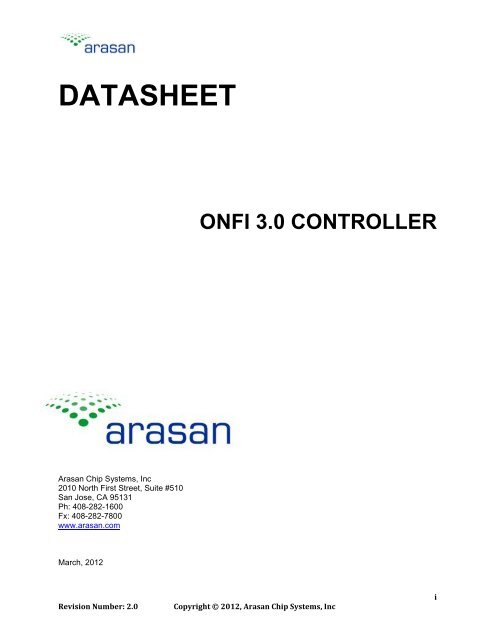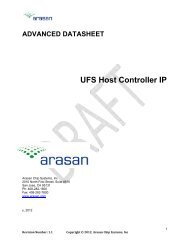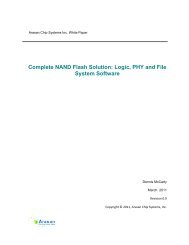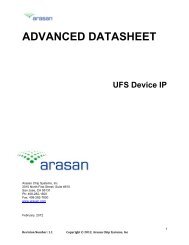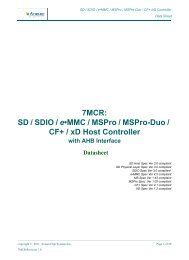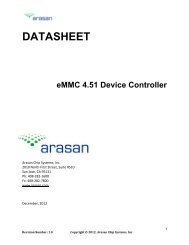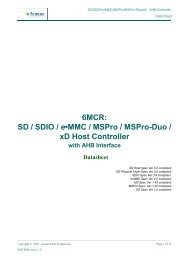ONFI3.0_Datasheet_Rev1.0 - Arasan
ONFI3.0_Datasheet_Rev1.0 - Arasan
ONFI3.0_Datasheet_Rev1.0 - Arasan
Create successful ePaper yourself
Turn your PDF publications into a flip-book with our unique Google optimized e-Paper software.
DATASHEET<br />
ONFI 3.0 CONTROLLER<br />
<strong>Arasan</strong> Chip Systems, Inc<br />
2010 North First Street, Suite #510<br />
San Jose, CA 95131<br />
Ph: 408-282-1600<br />
Fx: 408-282-7800<br />
www.arasan.com<br />
March, 2012<br />
Revision Number: 2.0<br />
Copyright © 2012, <strong>Arasan</strong> Chip Systems, Inc<br />
i
DISCLAIMER<br />
This document is written in good faith with the intent to assist the readers in the use of the product.<br />
Circuit diagrams and other information relating to <strong>Arasan</strong> Chip Systems’ products are included as a<br />
means of illustrating typical applications. Although the information has been checked and is<br />
believed to be accurate, no responsibility is assumed for inaccuracies. Information contained in this<br />
document is subject to continuous improvements and developments.<br />
<strong>Arasan</strong> Chip Systems’ products are not designed, intended, authorized or warranted for use in any<br />
life support or other application where product failure could cause or contribute to personal injury<br />
or severe property damage. Any and all such uses without prior written approval of an Officer of<br />
<strong>Arasan</strong> Chip Systems Inc. will be fully at the risk of the customer.<br />
<strong>Arasan</strong> Chip Systems Inc. disclaims and excludes any and all warranties, including without<br />
limitation any and all implied warranties of merchantability, fitness for a particular purpose, title,<br />
and infringement and the like, and any and all warranties arising from any course or dealing or<br />
usage of trade.<br />
This document may not be copied, reproduced, or transmitted to others in any manner. Nor may<br />
any use of information in this document be made, except for the specific purposes for which it is<br />
transmitted to the recipient, without the prior written consent of <strong>Arasan</strong> Chip Systems, Inc. This<br />
specification is subject to change at anytime without notice. <strong>Arasan</strong> Chip Systems Inc. is not<br />
responsible for any errors contained herein.<br />
In no event shall <strong>Arasan</strong> Chip Systems Inc. be liable for any direct, indirect, incidental, special,<br />
punitive, or consequential damages; or for lost of data, profits, savings or revenues of any kind;<br />
regardless of the form of action, whether based on contract; tort; negligence of <strong>Arasan</strong> Chip<br />
Systems or others; strict liability; breach of warranty; or otherwise; whether or not any remedy of<br />
buyers is held to have failed of its essential purpose, and whether or not <strong>Arasan</strong> Chip Systems Inc.<br />
has been advised of the possibility of such damages.<br />
Restricted Rights<br />
Use, duplication, or disclosure by the Government is subject to restrictions as set forth in<br />
FAR52.227-14 and DFAR252.227-7013 et seq. or its successor.<br />
Copyright Notice<br />
No part of this specification may be reproduced in any form or means, without the prior written<br />
consent of <strong>Arasan</strong> Chip Systems, Inc.<br />
Questions or comments may be directed to:<br />
<strong>Arasan</strong> Chip Systems Inc<br />
2010 North First Street<br />
Suite 510, San Jose, CA 95131.<br />
Ph: 408-282-1600<br />
Fx: 408-282-7800<br />
Email: sales@arasan.com<br />
http://www.arasan.com<br />
Revision Number: 2.0<br />
Copyright © 2012, <strong>Arasan</strong> Chip Systems, Inc<br />
i
CONTENTS<br />
1 INTRODUCTION ....................................................................................................................... 2<br />
1.1 <strong>ONFI3.0</strong> Controller Overview .............................................................................................. 2<br />
1.2 <strong>ONFI3.0</strong> Controller Features ................................................................................................ 3<br />
1.2.1 General ........................................................................................................................... 3<br />
1.2.2 Configuration ................................................................................................................. 3<br />
1.2.3 ECC ................................................................................................................................ 4<br />
1.2.4 Data Interface ................................................................................................................. 4<br />
1.2.5 System Interface............................................................................................................. 4<br />
2 ARCHITECTURE ....................................................................................................................... 5<br />
2.1 Functional Block Diagram .................................................................................................... 5<br />
2.2 Functional Block Diagram Description ................................................................................ 6<br />
2.3.1 NAND Flash Interface ................................................................................................... 6<br />
2.3.2 AHB Slave Interface ...................................................................................................... 6<br />
2.3.3 AHB Master Interface .................................................................................................... 6<br />
2.3.4 Dual-Port RAM .............................................................................................................. 6<br />
2.3.5 ECC ................................................................................................................................ 7<br />
2.3.6 Control Registers ........................................................................................................... 7<br />
2.3.7 Slave DMA Interface ..................................................................................................... 7<br />
2.3.8 Avalon Slave Interface (Optional)................................................................................. 7<br />
3 <strong>ONFI3.0</strong> CONTROLLER SIGNAL INTERFACES ................................................................... 8<br />
4 DELIVERABLES ...................................................................................................................... 17<br />
5 RELATED PRODUCTS ........................................................................................................... 17<br />
Revision Number: 2.0<br />
Copyright © 2012, <strong>Arasan</strong> Chip Systems, Inc<br />
ii
Tables<br />
Table 1: AHB Master Interface ....................................................................................................... 8<br />
Table 2 : AHB Slave Interface ........................................................................................................ 9<br />
Table 3: ONFI 3.0 PHY Interface ................................................................................................... 9<br />
Table 4: Slave DMA Interface ...................................................................................................... 10<br />
Table 5: Avalon Slave Interface (Optional).................................................................................. 10<br />
Table 6: AXI Master PIN Interface (Optional)............................................................................. 11<br />
Table 7: AXI Slave PIN Interface (Optional) ............................................................................... 13<br />
Table 8: RAM Interface ................................................................................................................ 15<br />
Table 9: Clock and Reset Signals ................................................................................................. 15<br />
Table 10: Environment Signals ..................................................................................................... 16<br />
Figures<br />
Figure 1: ONFI 3.0 Controller Functional Block Diagram............................................................. 5<br />
Revision Number: 2.0<br />
Copyright © 2012, <strong>Arasan</strong> Chip Systems, Inc<br />
1
1 INTRODUCTION<br />
1.1 <strong>ONFI3.0</strong> Controller Overview<br />
The NAND Flash landscape is changing and the <strong>Arasan</strong> NAND Flash Controller IP Core<br />
is changing with it. New applications are emerging and innovative IP solutions are needed<br />
to keep pace. NAND Flash is being incorporated into all types of products including<br />
portable memory drives, media players, digital cameras, Smart Phones, eBook Readers,<br />
Tablets, digital TVs, digital camcorders, PCs, and so on. <strong>Arasan</strong> is in the perfect position<br />
to give you what you need.<br />
The <strong>Arasan</strong> NAND Flash Controller IP Core is a full featured, easy to use, synthesizable<br />
core, easily integrated into any SoC or FPGA development. Designed to support both SLC<br />
and MLC flash memories, it is flexible in use and easy in implementation. The controller<br />
works with any suitable NAND Flash memory device up to 128Gbps from leading<br />
memory providers - Micron, Samsung, Toshiba and Hynix. The IP core includes a host of<br />
configuration options from page size to band selects. The controller offers Hamming Code<br />
(1-Bit error correction and 2-Bit error detection) and BCH (option for 4-, 8-, 12-Bit, and<br />
larger error correction) Error Code Correction (ECC) for optimized performance and<br />
reliability. Additional features include the capability to boot from flash.<br />
The IP core supports the Open NAND Flash Interface Working Group (ONFI) 1.0, 2.0,<br />
2.1, 2.2, 2.3 and 3.0 standard. It can also support a variety of host bus interfaces for easy<br />
adoption into any design architecture - AHB, APB, OCP, 8051 or custom buses. The slave<br />
AHB IP supports an external DMA interface where the master AHB incorporates an<br />
internal DMA controller.<br />
An optional NAND Flash File system is available to support advanced features. The file<br />
system converts complicated tasks of NAND flash memory interfacing to simple memory<br />
access. Flash memory read, write, garbage collection, bad block management and other<br />
functions are handled in the background by the file system.<br />
The <strong>Arasan</strong> NAND Flash Controller IP Cores are delivered in Verilog RTL that can be<br />
implemented in an ASIC or FPGA. They are fully tested with vendor models and<br />
hardware is tested with FPGA’s. The core includes RTL code, test scripts and a test<br />
environment for complete simulation and verification.<br />
Revision Number: 2.0<br />
Copyright © 2012, <strong>Arasan</strong> Chip Systems, Inc<br />
2
1.2 <strong>ONFI3.0</strong> Controller Features<br />
1.2.1 General<br />
Supports the following features:<br />
• Flash devices up to 128Gbps<br />
• NAND Flash memories from Micron, Samsung and Hynix<br />
• Boot mode support<br />
• All mandatory commands and selected optional commands<br />
• Full access to spare area<br />
• Speed ranging from 40MB/s to 400MB/s to allow applications to balance<br />
performance and power<br />
• Multi LUN/DIE Operations<br />
• Small Data Move<br />
• Change Row Address<br />
• Reset LUN<br />
• EZ - NAND devices<br />
• Chip_en pin reduction mechanism<br />
• ODT Configure<br />
• On-die termination<br />
Supports Interleaving Operations<br />
• Page Program Interleaving<br />
• Copyback Program Interleaving<br />
• Block Erase Interleaving<br />
• Read Interleaving<br />
• Cache Interleaving<br />
1.2.2 Configuration<br />
Page Size - 512B, 2KB, 4KB, 8KB, 16KB<br />
Bank/chip select options<br />
Programmable timing<br />
Revision Number: 2.0<br />
Copyright © 2012, <strong>Arasan</strong> Chip Systems, Inc<br />
3
1.2.3 ECC<br />
Address cycles - 4, 5<br />
ECC - enable, disable<br />
RAM size - 1KB, 2KB, and 4KB<br />
Supports parallel connection of two 8-bit flashes<br />
SLC - Hamming Code<br />
• 1-Bit error correction<br />
• 2-Bit error detection<br />
MLC - BCH<br />
• Standard support - 4, 8-Bit error correction<br />
• Additional support - many options including sizes greater than 32-Bit<br />
1.2.4 Data Interface<br />
ONFI 1.0, 2.0, 2.1, 2.2, 2.3 and 3.0 Compliant<br />
Supports SDR modes [0-5]<br />
Supports NV- DDR modes [0 -5]<br />
Supports NV- DDR2 modes [0 -7]<br />
8-bit data bus width support for SDR, and NV-DDR, and NV-DDR2<br />
16-bit data bus width support only for SDR mode<br />
Supports independent data bus<br />
1.2.5 System Interface<br />
AHB - AMBA 2.0 Compliant<br />
Optional Avalon Bus - Available up on request<br />
PIO Mode<br />
Slave DMA mode (Optional)<br />
Master DMA mode (Optional)<br />
Revision Number: 2.0<br />
Copyright © 2012, <strong>Arasan</strong> Chip Systems, Inc<br />
4
2 ARCHITECTURE<br />
This section describes the ONFI 3.0 Controller architecture and the description of internal<br />
blocks in detail.<br />
The IP core includes a host of configuration options from page size to band selects. The<br />
controller offers Hamming Code (1bit error correction and 2bit error detection) and BCH<br />
(option for 4-, 8-, 12-, up to 64 bit error correction) error code correction (ECC) for<br />
optimized performance and reliability. Additional features include the capability to boot<br />
from flash. The IP core supports the Open NAND Flash Interface Working Group (ONFI)<br />
3.0 standard and is backwards compatible. It uses differential signaling on the clock and data<br />
lines and clocks at any frequency up to 200MHz.<br />
The controller supports a variety of host bus interfaces for easy adoption into any design<br />
architecture. An optional NAND Flash file system is available to support advanced features.<br />
The file system converts complicated tasks of NAND flash memory interfacing to simple<br />
memory accesses. Flash memory read, write, garbage collection, bad block management,<br />
and other functions are handled by the file system in the background.<br />
2.1 Functional Block Diagram<br />
Figure 1: ONFI 3.0 Controller Functional Block Diagram<br />
Revision Number: 2.0<br />
Copyright © 2012, <strong>Arasan</strong> Chip Systems, Inc<br />
5
2.2 Functional Block Diagram Description<br />
2.3.1 NAND Flash Interface<br />
The NAND Flash Interface handles all the command, address and data sequences and<br />
manages all the hardware protocols. It is ONFI 1.0, 2.0, 2.1, 2.2, 2.3 and 3.0 compliant<br />
and provides an 8-bit or 16-bit interface to the flash memories. The interface supports a<br />
maximum of 128Gbps of NAND flash memory. All timing modes (0-5) are supported for<br />
SDR, NV-DDR and Timing modes (0-7) for NV-DDR2 mode.<br />
2.3.2 AHB Slave Interface<br />
The AHB Slave block consists of the operational registers. A processor connecting to the<br />
custom interface can control the operation of the NAND Flash controller through the<br />
NAND Flash control registers. Read/write operations of the flash memory can be<br />
performed through NAND flash interface.<br />
2.3.3 AHB Master Interface<br />
NAND Flash controller acts as a master during MDMA mode of transaction. The AHB<br />
master interface places control signals in AHB Bus depends upon the FIFO status. During<br />
write transaction, AHB master interface read data from system memory and stores into<br />
the FIFO. During read transaction, read data from FIFO and write data into system<br />
memory. AHB master interface asserts DMA interrupt when DMA buffer boundary is<br />
reached. The AHB master interface can be used to transfer boot code from the NAND<br />
flash memory to the system memory during system power-up.<br />
2.3.4 Dual-Port RAM<br />
This block has handshake logic to communicate with the AHB interface and on the other<br />
side communicates with the Flash Interface. Typical RAM size is 256x32, to support<br />
block size of 512 bytes. The FIFO depth is configurable.<br />
Revision Number: 2.0<br />
Copyright © 2012, <strong>Arasan</strong> Chip Systems, Inc<br />
6
2.3.5 ECC<br />
The ECC module provides error detection and correction support for SLC Flash memory<br />
as well as the MLC Flash memory. The Hamming Code supports 1 bit error correction<br />
and 2 bit error detection. The BCH Code supports many error correction sizes including<br />
sizes much greater than 32-Bit. For SLC Flash devices, Hamming Code logic is enabled<br />
and for MLC Flash devices, BCH is enabled. An optional pipeline stage in the BCH<br />
decoder can be enabled for maximum performance.<br />
2.3.6 Control Registers<br />
The host processor controls the configuration and operation of the NAND Flash<br />
Controller through the Control Registers. Configuration includes the set up time (tCCS,<br />
tDQSQ, tDS), memory configuration (address, page size, packet size, packet count),<br />
timing modes (SDR, NV-DDR, and NV-DDR2), and soon. The Control Registers also<br />
provide operating status such as Busy and Data Ready signals.<br />
2.3.7 Slave DMA Interface<br />
This interface is used to perform a SDMA mode of Write/ Read data transfer. Slave<br />
DMA Interface provides DMA Request, DMA Single and DMA Last and get<br />
acknowledged by DMA Acknowledge and DMA Finish. DMA Request is asserted until<br />
the required amount of data is transferred based on the DMA Transfer count. For the<br />
generated DMA Request Slave DMA Controller provides write data for write transfer or<br />
reads the data from FIFO for read transfer.<br />
2.3.8 Avalon Slave Interface (Optional)<br />
The NAND Flash Controller provides Programmed IO method in which the Avalon<br />
Master transfers data using the Buffer Data Port Register. The Avalon master programs<br />
the Control registers using Avalon Slave Interface. Data transaction is performed through<br />
Avalon Slave Interface.<br />
Revision Number: 2.0<br />
Copyright © 2012, <strong>Arasan</strong> Chip Systems, Inc<br />
7
3 <strong>ONFI3.0</strong> CONTROLLER SIGNAL<br />
INTERFACES<br />
This section contains description and the direction of the pins from interfaces such as AHB-<br />
Master, AHB- Slave, Avalon Slave, AXI Master, AXI Slave, Nand_Flash, SDMA, RAM<br />
and Environment signals.<br />
The Nand Flash controller has nine main interface groups:<br />
AHB Master Interface<br />
AHB Slave Interface<br />
ONFI 3.0 PHY Interface<br />
Slave DMA Interface<br />
Avalon Slave Interface (Optional)<br />
AXI Master Interface (Optional)<br />
AXI Slave Interface (Optional)<br />
RAM Interface<br />
Clock and Reset Signals<br />
Environment Signal<br />
Table 1: AHB Master Interface<br />
Pins Direction Description<br />
m_hbusreq Output AHB Bus Request<br />
m_hgrant Input AHB Bus Grant<br />
m_haddr[31:0] Output Address Bus<br />
m_hwdata[31:0] Output Write Data Bus<br />
m_hrdata[31:0] Input Read Data Bus<br />
m_hwrite Output Write or Read Direction Indication<br />
m_hsize[2:0] Output Size(Byte, Half Word or Word)<br />
m_hburst[2:0] Output Burst Size<br />
m_htrans[1:0] Output Transfer type<br />
m_hready Input Slave Ready<br />
m_hresp[1:0] Input Transfer Response<br />
boot_enable Input Reads Boot Code from Flash<br />
Revision Number: 2.0<br />
Copyright © 2012, <strong>Arasan</strong> Chip Systems, Inc<br />
8
Table 2 : AHB Slave Interface<br />
Pins Direction Description<br />
ahb_hsel Input Slave Select<br />
ahb_haddr[31:0] Input Address Bus (Byte Addresses)<br />
ahb_hwdata[31:0] Input Write Data Bus<br />
ahb_hrdata[31:0] Output Read Data Bus<br />
ahb_hwrite Input Write or Read Direction Indication<br />
ahb_hburst Input Burst (Single, Incrementing, wrapping)<br />
ahb_hsize[2:0] Input Size (Byte, Half Word or Word)<br />
ahb_htrans[1:0] Input Transfer Type<br />
ahb_hready_in Input Global Ready<br />
ahb_hready Output Slave Ready<br />
ahb_hresp[1:0] Output Transfer Response<br />
int_to_arm Output Interrupt to the ARM<br />
Table 3: ONFI 3.0 PHY Interface<br />
Pins Direction Description<br />
CLK_FLASH Input Source clock to ONFI 3.0 Digital Controller<br />
SDR_DATA_OUT[7:0] Output TX Data/Address/Command for SDR mode and<br />
Address/Command for DDR mode<br />
DDR_DATA_OUT[15:0] Output TX Data for NV-DDR and NV-DDR2 mode<br />
SDR_DATA_EN Output Enables SDR DATA<br />
DATA_OUT_EN Output Enables Data Direction<br />
DQS_EN Output Enables DQS_t & DQS_c<br />
ALE_OUT Output Address Latch Enable from Controller<br />
CLE_OUT Output Command Latch Enable from Controller<br />
CE_OUT Output Chip Enable from Controller<br />
RE_OUT Output Read Enable from Controller<br />
R_B_IN Input Ready Busy from External Flash Interface<br />
WE_out Output Write Enable from Controller<br />
DDR_RE_EN Output Read Strobe Enable for DDR Mode<br />
SDR_DATA_IN[7:0] Input RX Data for SDR mode<br />
SDR_DATA_VALID Input RX Data Valid for SDR mode<br />
DDR_DATA_IN[15:0] Input RX Data for DDR mode<br />
DDR_DATA_VALID Input RX Data Valid for DDR mode.<br />
PLL_EN Output Enables the PLL<br />
PLL_FREQ[4:0] Output Changes the Frequency of the PLL Output (CLK2X)<br />
MODE[1:0] Output SDR Mode/NV-DDR Mode/ NV-DDR2 Mode<br />
18V_EN Output 1.8V Enable<br />
DRIVE_STRENGTH[1:0] Output Programmable Drive Strength<br />
Revision Number: 2.0<br />
Copyright © 2012, <strong>Arasan</strong> Chip Systems, Inc<br />
9
Table 4: Slave DMA Interface<br />
Pins Direction Description<br />
dma_ack Input DMA Acknowledge<br />
This is asserted after the data phase of the last transfer in the<br />
current transaction (single or burst) to the peripheral has<br />
completed. It forms a handshaking loop with dma_req and<br />
remains asserted until the peripheral de-asserts dma_req<br />
(deasserted one HCLK cycle later).<br />
dma_finish Input DMA Finish<br />
DMA Controller block transfer complete signal. The DMAC<br />
asserts dma_finish in order to signal block completion. This<br />
uses the same timing as dma_ack and forms a handshaking<br />
loop with dma_req<br />
dma_req Output DMA Request<br />
Transaction request from peripheral. A rising edge on dma_req<br />
initiates a transaction request. The type of transaction – single<br />
or burst – is qualified by dma_single. Once dma_req is<br />
asserted, it must remain asserted until dma_ack is asserted.<br />
When the peripheral that is driving dma_req determines<br />
that dma_ack is asserted, it must de-assert dma_req<br />
dma_last Output DMA Last<br />
Last transaction in block. When the peripheral is the flow<br />
controller, it asserts dma_last on the same cycle as dma_req is<br />
asserted in order to signal that this transaction request is the<br />
last in the block; the block transfer is completed after this<br />
transaction is complete. If dma_single is high in the same<br />
cycle, then the last transaction is a single transaction. If<br />
dma_single is low in the same cycle, then the last transaction<br />
is a burst transaction<br />
dma_single Output DMA Single<br />
Single or burst transaction request. If dma_single is deasserted<br />
in the same clock cycle as a rising edge on dma_req, a<br />
burst transaction is requested by the peripheral. If asserted, the<br />
peripheral requests a single transaction<br />
Table 5: Avalon Slave Interface (Optional)<br />
Pins Direction Description<br />
s_address[7:0] Input Address lines from Avalon Bus Module<br />
s_byteenable[3:0] Input Byte enable signal to enable specific byte during slave transfer<br />
s_write Input 1’b1 - Write request signal to slave port<br />
s_read Input 1’b1 - Read request signal to slave port<br />
s_writedata[31:0] Input Data lines from Avalon Bus Module for write transfers.<br />
s_begintransfer Input Asserted during the first bus cycle of each new Avalon Bus<br />
transfer<br />
Revision Number: 2.0<br />
Copyright © 2012, <strong>Arasan</strong> Chip Systems, Inc<br />
10
Pins Direction Description<br />
s_beginbursttransfer Input Asserted for the first cycle of a burst to indicate when a burst<br />
transfer is starting<br />
s_burstcount[7:0] Input Used for burst transfer to indicate the number of transfers in a<br />
burst<br />
s_waitrequest Output Asserted when slave port is not able to respond immediately<br />
s_readdatavalid Output Used only by slaves with variable latency. Marks the rising<br />
clock edge when the slave asserts valid read data<br />
s_readdata[31:0] Output Data lines to the Avalon bus module for read transfers<br />
Table 6: AXI Master PIN Interface (Optional)<br />
Pins Direction Description<br />
axi_clk I Input AXI Clock. All signals are sampled on the rising edge of this<br />
clock.<br />
axi_reset_n Input Active Low Reset<br />
aximst_awid Output[3:0] Write address ID. This signal is the identification tag for the<br />
write address group of signals.<br />
aximst_awaddr Output [31:0] Write address. The write address bus gives the address of the<br />
first transfer in a write burst transaction. The associated<br />
control signals are used to determine the addresses of the<br />
remaining transfers in the burst.<br />
aximst_awlen Output [3:0] Burst length. The burst length gives the exact number of<br />
transfers in a burst. This information determines the number of<br />
data transfers associated with the address.<br />
aximst_awsize Output [2:0] Burst size. This signal indicates the size of each transfer in the<br />
burst.<br />
Byte lane strobes indicate exactly which byte lanes to update.<br />
aximst_awburst Output[1:0] Burst type. The burst type, coupled with the size information,<br />
details<br />
how the address for each transfer within the burst is calculated.<br />
aximst_awvalid Output Write address valid. This signal indicates that valid write<br />
address and control information are available:<br />
1 = address and control information available; 0 = address and<br />
control information not available.<br />
The address and control information remain stable until the<br />
address acknowledge signal, aximst_awready, goes HIGH.<br />
aximst_awready Input Write address ready. This signal indicates that the slave is<br />
ready to<br />
accept an address and associated control signals:<br />
1 = slave ready; 0 = slave not ready.<br />
aximst_wid Output[3:0] Write ID tag. This signal is the ID tag of the write data<br />
transfer. The aximst_wid value must match the aximst_awid<br />
value of the write transaction.<br />
aximst_wdata Output[31:0] Write data. The write data bus is 32 bits wide<br />
Revision Number: 2.0<br />
Copyright © 2012, <strong>Arasan</strong> Chip Systems, Inc<br />
11
Pins Direction Description<br />
aximst_wstrb Output[3:0] Write strobes. This signal indicates which byte lanes to update<br />
in memory. There is one write strobe for each eight bits of the<br />
write data bus. Therefore, aximst_wstrb[n] corresponds to<br />
aximst_wdata[(8 x n) + 7:(8 x n)].<br />
aximst_wlast Output Write Last. This signal indicates the last transfer in a write<br />
burst.<br />
aximst_wvalid Output Write valid. This signal indicates that valid write data and<br />
strobes are available:<br />
1 = write data and strobes available<br />
0 = write data and strobes not available.<br />
aximst_wready Input Write ready. This signal indicates that the slave can accept the<br />
write data: 1 = slave ready; 0 = slave not ready.<br />
aximst_bid] Input[3:0 Response ID. The identification tag of the write response. The<br />
aximst_bid value must match the aximst_awid value of the<br />
write transaction to which the slave is responding<br />
aximst_bresp Input[1:0] Write response. This signal indicates the status of the write<br />
transaction. The allowable responses are OKAY, EXOKAY,<br />
SLVERR, and DECERR.<br />
aximst_bvalid Input Write response valid. This signal indicates that a valid write<br />
response is available: 1 = write response available; 0 = write<br />
response not available.<br />
aximst_bready Output Response ready. This signal indicates that the master can<br />
accept the response information. 1 = master ready; 0 = master<br />
not ready.<br />
aximst_arid Output[3:0] Read address ID. This signal is the identification tag for the<br />
read address group of signals.<br />
aximst_araddr Output[31:0] Read address. The read address bus gives the initial address of<br />
a read burst transaction. Only the start address of the burst is<br />
provided and the control signals that are issued alongside the<br />
address detail how the address is calculated for the remaining<br />
transfers in the burst<br />
aximst_arlen Output[3:0] Burst length. The burst length gives the exact number of<br />
transfers in a burst.<br />
aximst_arsize Output[2:0] Burst size. This signal indicates the size of each transfer in the<br />
burst.<br />
aximst_arburst Output[1:0] Burst type. The burst type, coupled with the size information,<br />
details how the address for each transfer within the burst is<br />
calculated.<br />
aximst_arvalid Output Read address valid. This signal indicates, when HIGH, that the<br />
read address and control information is valid and will remain<br />
stable until the address acknowledge signal, aximst_arready, is<br />
high: 1 - address and control information are valid. 0 - address<br />
and control information are not valid.<br />
aximst_arready Input Read address ready. This signal indicates that the slave is<br />
ready to accept an address and associated control signal.<br />
1 - slave ready; 0 - slave not ready.<br />
Revision Number: 2.0<br />
Copyright © 2012, <strong>Arasan</strong> Chip Systems, Inc<br />
12
Pins Direction Description<br />
aximst_rid Input[3:0] Read ID tag. This signal is the ID tag of the read data group of<br />
signals. The RID value is generated by the slave and must<br />
match the aximst_arid value of the read transaction to which it<br />
is responding.<br />
aximst_rdata Input[31:0] Read data. The read data bus is 32<br />
aximst_rresp Input[1:0] Read response. This signal indicates the status of the read<br />
transfer. The allowable responses are OKAY, EXOKAY,<br />
SLVERR, DECERR.<br />
aximst_rlast Input Read Last.This signal indicates the last transfer in a read burst.<br />
aximst_rvalid Input Read valid. This signal indicates that the required read data is<br />
available and the read transfer can complete;<br />
1 - read data available<br />
0 - read data not available.<br />
aximst_rready Output Read ready. This signal indicates that the master can accept<br />
the read data and response information:<br />
1 - master ready<br />
0 - master not ready.<br />
Table 7: AXI Slave PIN Interface (Optional)<br />
Pins Direction Description<br />
axi_clk Input AXI Clock. All signals are sampled on the rising edge of this<br />
clock.<br />
axi_reset_n Input Active Low Reset.<br />
axislave_awid Input[3:0] Write address ID. This signal is the identification tag for the<br />
write address group of signals.<br />
axislave_awaddr Input[31:0] Write address. The write address bus gives the address of the<br />
first transfer in a write burst transaction. The associated<br />
control signals are used to determine the addresses of the<br />
remaining transfers in the burst.<br />
axislave_awlen Input[3:0] Burst length. The burst length gives the exact number of<br />
transfers in a burst. This information determines the number of<br />
data transfers associated with the address.<br />
axislave_awsize Input[2:0] Burst size. This signal indicates the size of each transfer in the<br />
burst. Byte lane strobes indicate exactly which byte lanes to<br />
update.<br />
axislave_awburst Input[1:0] Burst type. The burst type, coupled with the size information,<br />
details how the address for each transfer within the burst is<br />
calculated.<br />
axislave_awvalid Input Write address valid. This signal indicates that valid write<br />
address and control information are available:<br />
1 = address and control information available; 0 = address and<br />
control information not available.<br />
The address and control information remain stable until the<br />
address acknowledge signal, aximst_awready goes HIGH.<br />
Revision Number: 2.0<br />
Copyright © 2012, <strong>Arasan</strong> Chip Systems, Inc<br />
13
Revision Number: 2.0<br />
Pins Direction Description<br />
axislave_awready Output Write address ready. This signal indicates that the slave is<br />
ready to accept an address and associated control signals:<br />
1 = slave ready; 0 = slave not ready.<br />
axislave_wid Input [3:0] Write ID tag. This signal is the ID tag of the write data<br />
transfer. The aximst_wid value must match the aximst_awid<br />
value of the write transaction.<br />
axislave_wdata Input[31:0] Write data. The write data is 32 bits wide<br />
axislave_wstrb Input[3:0] Write strobes. This signal indicates which byte lanes to update<br />
in memory. There is one write strobe for each eight bits of the<br />
write data bus. Therefore, aximst_wstrb[n] corresponds to<br />
aximst_wdata[(8 x n) + 7:(8 x n)].<br />
axislave_wlast Input Write Last.This signal indicates the last transfer in a write<br />
burst.<br />
axislave_wvalid Input Write valid. This signal indicates that valid write data and<br />
strobes are available:<br />
1 = write data and strobes available<br />
0 = write data and strobes not available.<br />
axislave_wready Output Write ready. This signal indicates that the slave can accept the<br />
write data:<br />
1 = slave ready<br />
0 = slave not ready.<br />
axislave_bid Output[3:0] Response ID. The identification tag of the write response. The<br />
aximst_bid value must match the aximst_awid value of the<br />
write transaction to which the slave is responding.<br />
axislave_bresp Output[1:0] Write response. This signal indicates the status of the write<br />
transaction. The allowable responses are OKAY, EXOKAY,<br />
SLVERR, and DECERR.<br />
axislave_bvalid Output Write response valid. This signal indicates that a valid write<br />
response is available:<br />
1 = write response available<br />
0 = write response not available.<br />
axislave_bready Input Response ready. This signal indicates that the master can<br />
accept the response information.<br />
1 = master ready<br />
0 = master not ready.<br />
axislave_arid Input[3:0] Read address ID. This signal is the identification tag for the<br />
read address group of signals.<br />
axislave_araddr Input[31:0] Read address. The read address bus gives the initial address of<br />
a read burst transaction. Only the start address of the burst is<br />
provided and the control signals that are issued alongside the<br />
address detail how the address is calculated for the remaining<br />
transfers in the burst.<br />
axislave_arlen Input[3:0] Burst length. The burst length gives the exact number of<br />
transfers in a burst.<br />
axislave_arsize Input[2:0] Burst size. This signal indicates the size of each transfer in the<br />
burst.<br />
axislave_arburst Input[1:0] Burst type. The burst type, coupled with the size information,<br />
details how the address for each transfer within the burst is<br />
calculated.<br />
Copyright © 2012, <strong>Arasan</strong> Chip Systems, Inc<br />
14
Pins Direction Description<br />
axislave_arvalid Input Read address valid. This signal indicates, when HIGH, that the<br />
read address and control information is valid and will remain<br />
stable until the address acknowledge signal, aximst_arready, is<br />
high 1 - address and control information are valid; 0 - address<br />
and control information are not valid.<br />
axislave_arready Output Read address ready. This signal indicates that the slave is<br />
ready to accept an address and associated control signal.<br />
1 - slave ready; 0 - slave not ready.<br />
axislave_rdata Output[31:0] Read data. The read data bus is 32 bits wide.<br />
axislave_rresp Output[1:0] Read response. This signal indicates the status of the read<br />
transfer. The allowable responses are OKAY, EXOKAY,<br />
SLVERR, DECERR.<br />
axislave_rlast Output Read Last. This signal indicates the last transfer in a read<br />
burst.<br />
axislave_rvalid Output Read valid. This signal indicates that the required read data is<br />
available and the read transfer can complete;<br />
1 - read data available; 0 - read data not available.<br />
axislave_rready Input Read ready. This signal indicates that the master can accept<br />
the read data and response information:<br />
1 - master ready; 0 - master not ready.<br />
Table 8: RAM Interface<br />
Pins Direction Description<br />
data_to_sys [31:0] Input AHB domain data output<br />
data_to_flash_from_ Input Flash domain data output<br />
fifo [31:0]<br />
ram_addr_a Output Address bus for AHB domain<br />
wr_data_a [31:0] Output AHB domain data input<br />
cen_a Output Active high chip select.(AHB domain)<br />
wren_a Output Active high write enable signal.(AHB domain)<br />
ram_addr_b Output Address bus for Flash domain<br />
wr_data_b [31:0] Output Flash domain data input<br />
cen_b Output Active high chip select.(Flash domain)<br />
wren_b Output Active high write enable signal.(Flash domain)<br />
Table 9: Clock and Reset Signals<br />
Pins Direction Description<br />
clk_sys Input System clock<br />
clk_flash Input Source clock to ONFI 3.0 Digital Controller<br />
rst_n Input Active low Asynchronous power on reset from external<br />
environment and it is synchronized inside the IP. The<br />
synchronized reset is used to reset all the flops in FLASH,<br />
AHB clock domain<br />
Revision Number: 2.0<br />
Copyright © 2012, <strong>Arasan</strong> Chip Systems, Inc<br />
15
Table 10: Environment Signals<br />
Pins Direction Description<br />
clk_sys Input System clock<br />
clk_flash Input Source clock to ONFI 3.0 Digital Controller<br />
rst_n Input Active low Asynchronous power on reset from external<br />
environment and it is synchronized inside the IP. The<br />
synchronized reset is used to reset all the flops in FLASH,<br />
AHB clock domain<br />
Scan_mode<br />
.<br />
Input<br />
Active Low.<br />
1’b0 - Byepass all reset signals generated internally<br />
1’b1 - POR will be asserted Asynchronously<br />
Note: ONFI clk_flash Frequency<br />
Asynchronous Mode<br />
1. Firmware should program clock for 100MHz<br />
2. Firmware should wait for clock stable in PLL<br />
3. Firmware should enable the internal clock and program the mode of operation in<br />
program register.<br />
Synchronous Mode<br />
1. Firmware should program the appropriate frequency.<br />
2. Firmware should wait for clock stable in PLL<br />
3. Firmware should enable the internal clock and program the mode of operation in<br />
program register.<br />
Note: rst_flash_n<br />
Active low Asynchronous reset to rest the FLASH domain Flops. This synchronized<br />
reset signal is generated internally based on the rst_n signal in FLASH clock domain.<br />
Note: rst_sys_n<br />
Active low Asynchronous reset to reset the AHB domain Flops. This synchronized reset<br />
signal is generated internally based on the rst_n signal in AHB clock domain.<br />
Revision Number: 2.0<br />
Copyright © 2012, <strong>Arasan</strong> Chip Systems, Inc<br />
16
4 DELIVERABLES<br />
The full IP package complete with:<br />
Verilog HDL of the IP core<br />
Test environment and test scripts<br />
Synthesis scripts<br />
Sample ARM firmware and software drivers<br />
5 RELATED PRODUCTS<br />
Onsite support and design services<br />
Revision Number: 2.0<br />
Copyright © 2012, <strong>Arasan</strong> Chip Systems, Inc<br />
17


